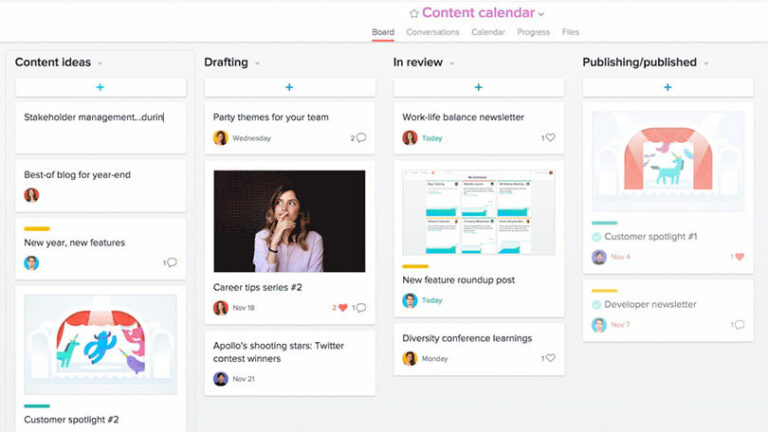
[ad_1]
Some productivity tools really don’t make much sense until you see them in action. So, if you’ve never used kanban boards, you might not have understood what all the buzz surrounding around top workflow-management and collaboration service Asana adding Kanban boards. If you’re interested in being more productive at work, however, it’s worth looking into, as I’ll explain.
For the uninitiated, online app Asana (Visit Site at Asana)(Opens in a new window) that has gained a lot of traction recently. This service is basically a to-do list on steroids. You can use Asana with a group of people, and it’s quite popular in workplaces. What’s new in Asana as of last week is a feature called boards, based on kanban boards. Kanban is a generic term that describes both a type of app and a system for using that app. One of the most well-known kanban board apps is Trello (Visit Site at Trello)(Opens in a new window) .
Kanban is also quite popular among IT teams and software development teams. When they describe it, they throw around terms like Scrum and just-in-time delivery, expecting us regular folk to understand what they mean. It’s very confusing.
A much easier and clearer way to understand kanban is to see examples of it in action. Below are some examples of kanban boards that may be less common in the workplace, but which are designed to make sense to nearly anyone.
1. Track Personal Tasks: To Do, Doing, Done
One way to use a kanban board is to organize a personal to-do list and make sure you never take on too many tasks at once. Let’s call this the To Do, Doing, Done board.
In this setup, you have three columns labeled To Do, Doing, and Done. You also have a stack of sticky notes, which in kanban are called cards. You write your tasks on the sticky notes, one task per note, and stick them in the To Do column. So far, so good.
Right now, we have a list of tasks in the To Do column, and nothing in the Doing or Done columns. I know you can see where this is going, but don’t jump to the next step just yet.
What you need to understand about kanban boards is they are visualizations of information that you could just as easily track in some other way. In Asana, you could instead look at your tasks in list view, using headers within the list to differentiate between different types of tasks, as in the image below.

But when you visualize the same information in board view, it can have a different psychological effect. With To Do, Doing, Done boards, people typically self-impose a limit on how many tasks can be in their Doing column at any given time. The purpose is to create a system that guides you to focus on only a few active tasks. With a list view, it’s easy to feel like all the tasks are of equal importance, and they all need to be completed right now!
The To Do, Doing, Done kanban board works really well for complicated tasks that have a lot of steps. In the images above and below, you can see that many of the tasks are big and can’t get done in a single day. Limiting the Doing list to only two or three tasks at most encourages you to focus on them until they’re finished.
It’s very simple to apply the same concept of limiting work in progress (Doing) to a team settings as well.
2. Distribute Work Through a Shared Tasks Bin
Here’s another example that’s fairly straightforward. You can use a kanban board to make work available for individuals on a team to pick up and assign to themselves.
To make it easy to understand, let’s pretend that this is a household chores list. This household has three kids: Andy, Berta, and Claudio. The first kanban column is Chores. The next columns are Andy, Berta, and Claudio. The last column is Done.
The household rule is that each child must choose one chore to do every Saturday. Additional chores might come up from time to time, too. The kids have autonomy to choose their chore based on what’s available. They make a selection, pull that card into their column, and therefore claim responsibility for it. When they finish their chores, they move the card to the Done column.

3. Manage Contacts
A more unusual way to use a kanban board is to keep lists of contacts based on region or city. Again, it could just as easily be in a list format, but for many people, seeing columns and cards has a different (positive) psychological effect.
This time, simple enough, the board has columns for various regions and cities. Each card is a contact who is based in that region. When travel takes you to a particular place, you can easily look at a list of contacts you might reach out to while there. Additionally, you’ll notice very quickly if a growing number of important contacts happen to be in the same location, which might mean you need to increase how often you visit.

Do More With Kanban Boards
Hopefully these examples made kanban boards a little more accessible to the uninitiated. Their use can be much more complicated, from the software development tracking I hinted at earlier to inventory control. The more basic examples I gave are designed to help you understand why you might use a board in Asana rather than a list. Be creative and use boards to manage whatever makes the most sense to you.
Looking for more information on Asana? You can read Using Asana in Business, 7 Asana Tricks to Become One With Business Workflows, and Slack vs Asana.
[ad_2]
Source link : https://www.pcmag.com/how-to/get-organized-3-ways-to-use-asanas-new-kanban-boards

